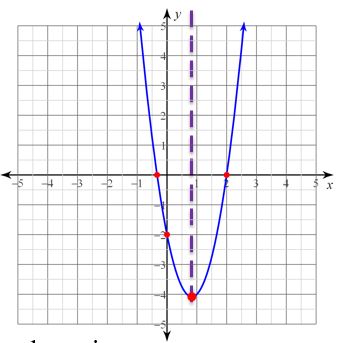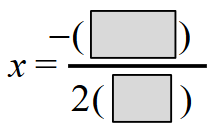Learn
Practice Problems
Practice Problem #1
Graph y = 3x2− 5x− 2
Step 1) Find the axis of symmetry.
![]()


Step 2) Find the vertex. We know from the first step that 
Plug  into the equation y = 3x2− 5x− 2 to solve for y.
into the equation y = 3x2− 5x− 2 to solve for y.

Evaluate the exponents first.

Evaluate the multiplication next.

Add by getting a common denominator.

Subtract.

The vertex is  .
.
Step 3) Find the x-intercepts. Set y equal to 0 and solve.
0 = 3x2 − 5x − 2
To solve, factor the equation. Find the factors of a times c that add to equal b.
The factors of −6 that add to equal −5 are−6 and 1.
Remember to divide by a and reduce.

Answer: 6 ,1

![]()
x−2 = 0 or x + ![]() = 0
= 0
x = 2 or x = ![]()
Axis of Symmetry: 
Vertex: 
x-intercepts: (![]() , 0) and (2, 0)
, 0) and (2, 0)
Step 4) Find the y-intercept. The y-intercept is the c value.
c =
The y-intercept is (0, −2).
We will now graph everything that we have found.
- Axis of symmetry:

- The vertex is:
 or
or 
- x-intercepts: (
 , 0) and (2, 0)
, 0) and (2, 0) - y-intercept: (0, −2)
Now, draw a quadratic curve connecting the points.

Practice Problem #2
Determine the vertex of the function f(x) =−4x2− 16x + 2.
Why did the example use f(x) instead of y?
Hint: Always remember that f(x) can always be used in place of y. They both have the same meaning.
Using the formula ![]() , find the x-coordinate of the vertex.
, find the x-coordinate of the vertex.
Substitute for b =−16 and a =−4. The negative on the outside must remain outside the parentheses.


Simplify the numerator and denominator.

x = ___blank
You just found the x-coordinate to be x = −2. Substitute this value into the original equation to find the y-coordinate.
f(x) = −4(−2)2− 16 (−2) + 2
Simplify using the order of operations.
y = −4( ___blank ) + ___blank + 2
Simplify using the order of operations.
y = ___blank + 32 + 2
Simplify using the order of operations.
y = ___blank
You found that x =−2 and y = 18. What is the vertex of your parabola?
( ___blank, ___blank )
- Find the vertex of y = 3x2 + 12x + 2
- (2, 38)
- (−2, −10)
- (−2, −34)
- (2, 36)
Answer: b. (−2, −10)
- Find the axis of symmetry for y = 4x2 + 16x − 2.
- x = 8
- x = −8
- x = −2
- x = 2
Answer: c. x = −2
- Find the y-intercept of y = x2 − 5x − 14
- (0, 14)
- (−7, 0) and (2, 0)
- (7, 0) and (2, 0)
- (0, −14)
Answer: d. (0, −14)
- Find the x-intercept(s) of y = x2 − 5x − 14
- (0, 14)
- (0, −14)
- (−7, 0) and (2, 0)
- (7, 0) and (−2, 0)
Answer: d. (7, 0) and (−2, 0)
- Find the y-intercept of y = 3x2 − 10x − 24
- (0, −8)
- (0, −24)
Answer: b. (0, −24)